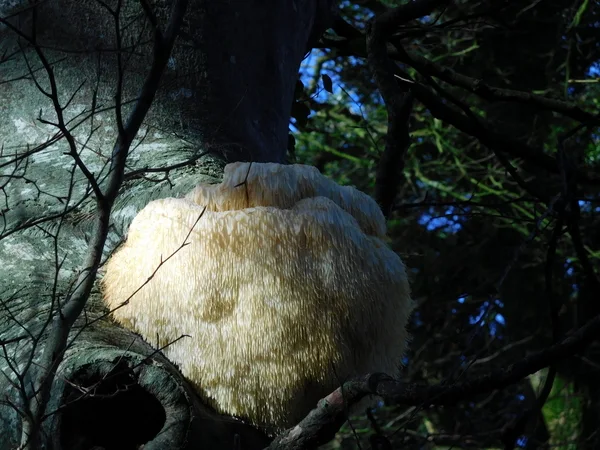If Father Christmas appears beardless in our skies this Christmas then he could do worse than to visit North Devon to reclaim his famous white facial fuzz.
The discovery of a rare and weird looking fungus has led to it being nicknamed ‘Santa’s beard’ by amazed staff at the wildlife conservation charity Devon Wildlife Trust. The fungus, which is more usually known by its scientific name Hericium erinaceus and by other names including hedgehog fungus and lion’s mane fungus, has been spotted near the village of Thornbury, in North Devon. The fungus is rarely seen in the UK and it’s thought to be only the second sighting of it in Devon, and only the 215th time it has been recorded in the UK since 1923.
The white, football-sized mass was spotted growing from the trunk of a tree by Meg Galley-Taylor as she drove along a road close to her North Devon home. Meg said:
“People call me ‘Curious Meg’ so of course I spotted the fungus! It is large, white and very conspicuous. I had no idea what it was but I knew I had never seen anything like it before.”
After returning with binoculars and her camera, Meg set about researching the strange object, trying to find out just what it was. Meg said:
The discovery of a rare and weird looking fungus has led to it being nicknamed ‘Santa’s beard’ by amazed staff at the wildlife conservation charity Devon Wildlife Trust. The fungus, which is more usually known by its scientific name Hericium erinaceus and by other names including hedgehog fungus and lion’s mane fungus, has been spotted near the village of Thornbury, in North Devon. The fungus is rarely seen in the UK and it’s thought to be only the second sighting of it in Devon, and only the 215th time it has been recorded in the UK since 1923.
The white, football-sized mass was spotted growing from the trunk of a tree by Meg Galley-Taylor as she drove along a road close to her North Devon home. Meg said:
“People call me ‘Curious Meg’ so of course I spotted the fungus! It is large, white and very conspicuous. I had no idea what it was but I knew I had never seen anything like it before.”
After returning with binoculars and her camera, Meg set about researching the strange object, trying to find out just what it was. Meg said:
“In the end I posted the picture on-line and then I started to get a response. At that point I thought, oh wow, this is seriously rare.”
Meg also reported her sighting to leading conservation charity Devon Wildlife Trust. The Trust’s Steve Hussey said:
“This fungus is usually spotted in North American and Asia but has occurred in the South West of England only rarely before. We’re so pleased that Meg managed to spot it and tell us about it. Fungi come in wondrous and fascinating forms, but this is one of the most unusual we’ve ever seen.”
“Its weird shape and shaggy appearance, combined with the Christmas spirit here in the office, to make us wonder if the fungus could be part of the Santa Claus story? If the great man does appear without his beard this Christmas then we will know where to send him to look for it: it’ll be hanging on a tree in North Devon.”





